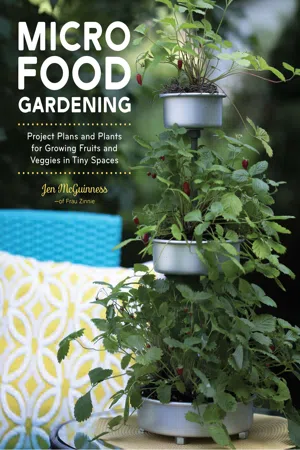
Micro Food Gardening
Project Plans and Plants for Growing Fruits and Veggies in Tiny Spaces
- 192 pages
- English
- ePUB (mobile friendly)
- Available on iOS & Android
Micro Food Gardening
Project Plans and Plants for Growing Fruits and Veggies in Tiny Spaces
About This Book
Tiny plants are poised to take over the gardening world. And no category of tiny plants is as welcome and wildly embraceable as tiny edibles. Not only are they cute as a button, but they're tasty and nutritious too! In Micro Food Gardening, author and small-space gardening pro Jen McGuinness, introduces you to a world of miniature edible plants and dozens of DIY projects for growing them. Not everyone has room to grow a full-sized tomato plant or a melon vine that takes up more room than your car, but everyone has space for a micro tomato that tops out at the height of a Barbie doll or a dwarf watermelon with vines that won't grow any longer than your leg. From miniature herbs and salad greens to tiny strawberry plants, baby beets, and mini cabbages, you'll quickly discover that micro gardening offers a surprisingly diverse and delicious array of edible opportunities. Plus, with step-by-step instructions for a plethora of DIY micro food gardening projects, you'll be up and growing in no time at all. Whether you micro garden on a high-rise balcony, an itty bitty patio, a front porch container, or even in a basket on the handlebars of your bicycle, there are mini food plants ready to start cranking out fresh produce just a few weeks after planting. Creative projects include:
- A window boxof mini potatoes for a porch, deck, or fire escape railing
- A mini lettuce table that serves to both grow food and hold your beverage
- A compact "cake tower" of strawberry plants
- A wine box spice garden
- A mini food fountain with herbs, veggies, and edible flowers
- A small-spaceomelet garden for cooking up the perfect breakfast
Plus, several indoor food-growing projects will have you enjoying homegrown micro veggies year-round, even in cold climates. With advice on plant selection and care, project plans, full color photography, and growing tips, Micro Food Gardening is here to show you the joys of growing your own fresh, organic food, no matter where you call home.
Frequently asked questions
Information
SECTION 1

SETTING UP YOUR SPACE

ASSESSING YOUR OUTDOOR SPACE
ASSESSING YOUR INDOOR SPACE


STARTING MICRO FOOD BY SEED

Table of contents
- Cover
- Title Page
- Contents
- Introduction: Why Grow Micro Food?
- Section 1: Setting Up Your Space
- Section 2: Micro Food Growing Projects
- Conclusion
- Resourcess
- Meet Jen McGuinness
- Author Acknowledgments
- Index
- Copyright